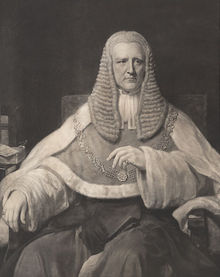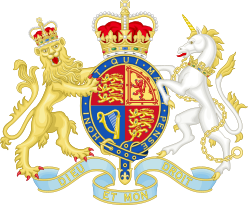John Coleridge, 1. Baron Coleridge
John Duke Coleridge, 1. Baron Coleridge PC (* 3. Dezember 1820 in Ottery St. Mary; † 14. Juni 1894 in London) war ein britischer Anwalt, Richter und Politiker.
Coleridge war der älteste Sohn von Sir John Taylor Coleridge und der Großneffe des Dichters Samuel Taylor Coleridge. Er besuchte das Eton College und studierte dann am Balliol College, Oxford. Von 1853 bis 1854 war er Sekretär der Royal Commission on the City of London.[1] Im Jahre 1865 wurde er für die Liberal Party ins House of Commons gewählt. Von 1868 bis 1873 war er zunächst Attorney General und dann Solicitor General. Er wechselte dann in das Amt des Chief Justice of the Common Pleas, das er sieben Jahre innehatte. Bereits am 10. Januar 1874 wurde Coleridge als Baron Coleridge, of Ottery St. Mary in the County of Devon, in den erblichen Adelsstand erhoben.
1880 wurde er Lord Chief Justice of England.
Lord Coleridge war mit Jane Fortescue Seymour verheiratet und hatte mit ihr vier Kinder. Seine erste Frau starb 1878. Er heiratete 1885 Amy Augusta Jackson Lawford. Lord Coleridge starb 74-jährig am 14. Juni 1894. Seinen Titel erbte sein ältester Sohn Bernard, der ebenfalls ein bekannter Richter wurde.
Weblinks
- John Coleridge im Hansard (englisch)
Einzelnachweise
- ↑ List of commissions and officials: 1850-1859 (nos. 53-94). Office-Holders in Modern Britain: Volume 9. 1984. Abgerufen am 10. März 2008.
Weblinks
| Vorgänger | Amt | Nachfolger |
|---|---|---|
| Titel neu geschaffen | Baron Coleridge 1874–1894 | Bernard Coleridge |
| Personendaten | |
|---|---|
| NAME | Coleridge, John, 1. Baron Coleridge |
| ALTERNATIVNAMEN | Coleridge, John |
| KURZBESCHREIBUNG | englischer Anwalt, Politiker, Mitglied des House of Commons und Richter |
| GEBURTSDATUM | 3. Dezember 1820 |
| GEBURTSORT | Ottery St. Mary |
| STERBEDATUM | 14. Juni 1894 |
| STERBEORT | London |
Auf dieser Seite verwendete Medien
Autor/Urheber: Sodacan, Lizenz: CC BY-SA 3.0
Royal Coat of Arms of the United Kingdom of Great Britain and Northern Ireland in the style used by the Government of Queen Elizabeth II from 1952 to 2022 (as used in all places except Scotland).
| “ | Quarterly, First and Fourth Gules three lions passant guardant in pale Or armed and langued Azure (for England), Second quarter Or a lion rampant within a double tressure flory counter-flory Gules (for Scotland), Third quarter Azure a harp Or stringed Argent (for Ireland), the whole surrounded by the Garter; for a Crest, the imperial crown Proper; for Supporters, dexter a lion rampant guardant Or crowned as the Crest, sinister a unicorn Argent armed, crined and unguled Proper, gorged with a coronet Or composed of crosses patée and fleurs de lys a chain affixed thereto passing between the forelegs and reflexed over the back also Or; Motto 'Dieu et mon Droit’ ('God and my Right') below the shield. | ” |
- PINCHES, J.H & R.V., The Royal Heraldry of England, 1974, Heraldry Today.



